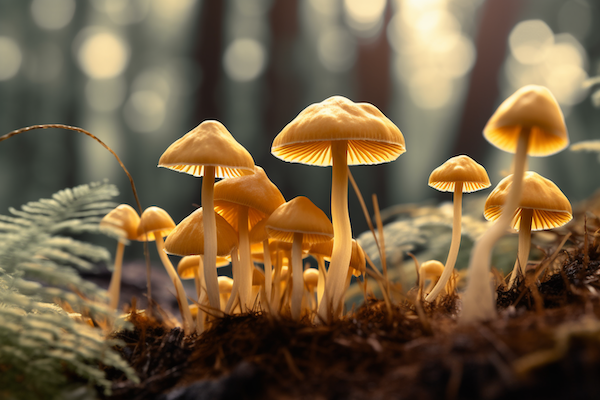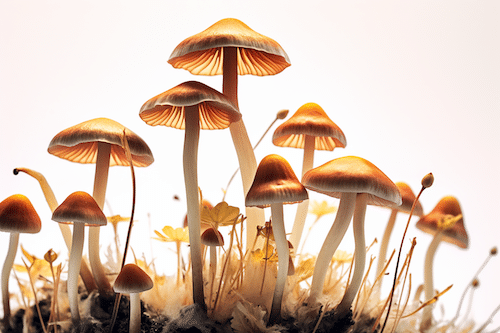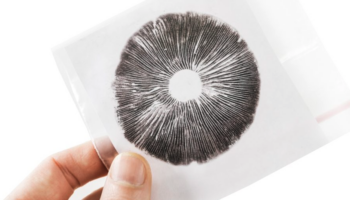Disclaimer: Psilocybin is a largely illegal substance, and we do not encourage or condone its use where it is against the law. However, we accept that illicit drug use occurs and believe that offering reliable harm reduction information is imperative to keeping people safe. Therefore, this guide is designed to ensure the safety of those who decide to use psilocybin.
Psilocybe azurescens is a psychedelic mushroom that contains psilocybin and psilocin, which are psychoactive compounds that can produce hallucinogenic effects when ingested. This species is also called “flying saucers” and “blue angels.”
This potent species is known for its high psilocybin and psilocin content, which can lead to a deeply transformative psychedelic experience. However, there’s more to Psilocybe azurescens than just its effects.
In this guide, we’ll dive into the fascinating history of Psilocybe azurescens, from its discovery in the Pacific Northwest to its popularity in modern times. We’ll explore the potential benefits of these mushrooms, including their use in therapeutic settings and their ability to promote creativity and introspection.
But most importantly, we’ll take a deep dive into the psychedelic experience with Psilocybe azurescens. What can you expect from a trip with these “flying saucers” or “blue angels”? How do they compare to other species of psychedelic mushrooms? And what can you do to prepare for and integrate your experience?
Whether you’re a seasoned psychonaut or simply curious about the world of psychedelics, this guide will provide valuable insights into Psilocybe azurescens and its potential for personal growth and transformation.
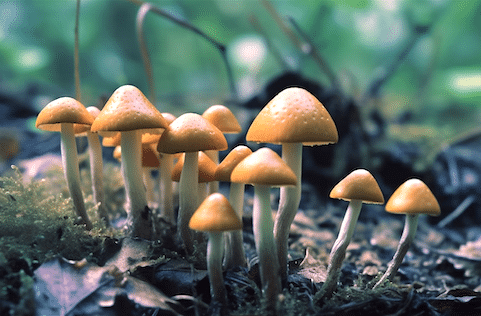
What Are Psilocybe azurescens Mushrooms?
Psilocybe azurescens mushrooms are a species of psychedelic mushroom that can produce hallucinogenic effects due to their high concentrations of psilocybin and psilocin.
Native to the Pacific Northwest region of North America, particularly around the coast of Oregon and Washington, this species has also been cultivated in other parts of the world, including Germany, the Netherlands, New Zealand, British Columbia, and the United Kingdom [1].
P. azurescens mushrooms prefer to grow on deciduous wood chips or sandy soils with a lot of woody debris, particularly on coastal dunes [2]. They typically grow in groups, but can also be found individually. The mycelial network of these mushrooms is dense and extensive, allowing them to firmly anchor onto their substrate, the material where their “roots” grow.
Are Psilocybe azurescens Mushrooms Psychedelic?
What makes Psilocybe azurescens mushrooms truly unique is their potency. They are considered one of the most potent species of psychedelic mushrooms, containing psilocybin levels that are higher than many other species, such as Psilocybe cubensis.
In fact, their high potency is what has earned them the nickname “blue angels.” Psilocybe azurescens can contain up to 1.8% psilocybin, 0.5% psilocin, and 0.4% baeocystin by dry weight, while Psilocybe cubensis typically contains up to 0.14-0.42% psilocybin.
If you’re considering trying Psilocybe azurescens mushrooms, it’s important to keep in mind that their high potency also means that they can produce a more intense and potentially overwhelming psychedelic experience compared to other species. It’s essential to do your research and take proper precautions to ensure a safe and positive experience.
For a list of vetted psilocybin providers and retreats, check out Third Wave’s provider directory.
What Do Flying Saucer Mushrooms Look Like?
Psilocybe azurescens‘ caramel-colored caps, broad umbo, and white stems are recognizable characteristics.
However, what sets them apart is their distinct “nipple-like shaped” umbo, which is situated at the center of the cap.
There are other distinguishing features of Psilocybe azurescens aside from their unique shape:
- Their cap is typically 3 to 10 cm in diameter and is convex or bell-shaped, becoming flat as the mushroom matures.
- The cap’s color ranges from caramel to rusty brown, with tiny hairs covering it.
- The cap is hygrophanous, which means it changes color when it dries, often to a brownish or yellow shade.
- The gills, or lamellae, of the mushroom are dark purplish-brown, while the stem is thick and white, typically around 5 to 10 cm long.
- Psilocybe azurescens spore prints are dark purple-brown.
One of the unique features of these mushrooms is their blue staining characteristic. They turn blue when picked, bruised, or damaged due to the oxidation of psilocybin [3].
Distinguishing Psilocybe azurescens from other Psilocybe species can be challenging, as they often appear similar and grow in the same habitat. Mushroom identifiers classify them as little brown mushrooms (LBMs), which means they are small, brown, and challenging to tell apart.
Avoid Mistaken Mushroom Foraging
If you plan on collecting P. azurescens in the wild, it’s important to correctly identify them to avoid mistakenly ingesting a toxic or poisonous lookalike.
Several other psilocybin-containing mushroom species resemble P. azurescens and are commonly found in the same habitats. Here are some of them and how to distinguish them from P. azurescens:
Psilocybe cyanescens
The Psilocybe cyanescens species has many similarities to P. azurescens, including appearance, psychedelic effects, habitat, and growing season. They both grow on wood chip mulch and favor cool temperatures, often appearing in the same regions, such as the Pacific Northwest.
One way to distinguish the two species is by their cap shape. Cyanescens mushrooms have a wavy cap, while azurescens have a more convex and broad cap.
Check out our guide on Psilocybe cyanescens to learn more about this wavy-psychedelic species, including its history, culture, psychedelic effects, and benefits.
Another wood-loving species, Psilocybe allenii, often has similarities with Psilocybe azurescens, such as their appearance in the Pacific Northwest. However, they have significant differences in their morphology, so it is not difficult to distinguish these species.
Psilocybe subaeruginosa
Psilocybe subaeruginosa is an Australian psychedelic mushroom species that prefers woody, cold environments. These two mushrooms have a similar appearance – caramel caps and white stems.
They also have notable differences. On the center of the cap, the so-called umbo, P. azurescens has a unique nipple-like structure that other mushrooms do not have.
Psilocybe weraroa
Psilocybe weraroa is a psychedelic species native to New Zealand, while Psilocybe azurescens mainly grows in North America. They also differ in their morphology, with distinct cap appearances. P. werarora also do not have the nipple-like structure on their umbo, which makes it easier to distinguish them from P. azurescens.
Psilocybe semilanceata (aka. Liberty Cap)
While P. semilanceata shares some similarities in appearance with P .azurescens, P. semilanceata primarily grows in dune grass and has a pointed, conical cap.
Proper identification is crucial when foraging for wild mushrooms, and it’s always best to consult an experienced identifier or guidebook when in doubt.
P. azurescens History and Cultural Significance
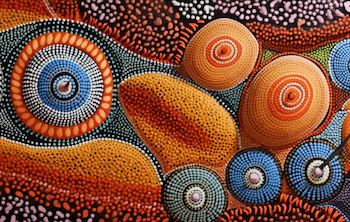
Psilocybin mushrooms have played a significant role in various cultures, from aboriginals to Mesoamerican culture. The evidence shows that the Aztecs, Mayans, and other indigenous peoples used them in religious ceremonies [4].
In the mid-20th century, psilocybin mushrooms gained attention in the West when mycologist R. Gordon Wasson and his wife traveled to Mexico and participated in a mushroom ceremony with the Mazatec people. Wasson published an article on magic mushrooms in 1957, which influenced psychologist Timothy Leary to initiate the Harvard Psilocybin Project studying how these substances affect the brain.
Brief History
Psilocybe azurescens was first identified and named as a distinct species in 1979 by mycologists Paul Stamets and Jochen Gart. The discovery of P. azurescens as a unique species occurred when Stamets found a previously undocumented species of psilocybin-containing mushroom growing near the mouth of the Columbia River in Oregon.
Stamets and Gartz officially named and described Psilocybe azurescens in 1995 in the scientific journal Mycotaxon. The publication included detailed descriptions of the species’ physical characteristics, including its spore print, cap color, and stem morphology, as well as its distribution and habitat.
Since its formal identification, P. azurescens has become a subject of interest for both scientific researchers and recreational users of psychedelic mushrooms.
Culture
Psilocybin mushrooms, including Psilocybe azurescens, have a long history of use in indigenous cultures across the globe. In North America, Native American tribes are known to have used these mushrooms in their spiritual and religious practices. The Mazatec people of Mexico have a long history of using psilocybin mushrooms, including Psilocybe azurescens, for medicinal and spiritual purposes.
During the 1960s and 1970s, psilocybin mushrooms became popular among the counterculture and hippie movement in the United States. The recreational use of psilocybin mushrooms, including Psilocybe azurescens, became more widespread, and they were used for their psychoactive effects. In addition, scientists and researchers were interested in studying the potential therapeutic benefits of psilocybin for various mental health conditions.
However, the recreational and medicinal use of psilocybin was not without controversy, and in 1986, psilocybin was made illegal in the United States and classified as a Schedule I drug, meaning it has no recognized medical use and a high potential for abuse.
Despite its legal status, the use of psilocybin mushrooms, including Psilocybe azurescens, continues to be a part of the cultural and spiritual practices of some communities and individuals, as well as the subject of ongoing scientific research.
Taxonomy
Here is the taxonomy of the P. azurescens species:
Kingdom: Fungi
Division: Basidiomycota
Class: Agaricomycetes
Order: Agaricales
Family: Hymenogastraceae
Genus: Psilocybe
Species: azurescens
The Effects of Flying Saucer Mushrooms
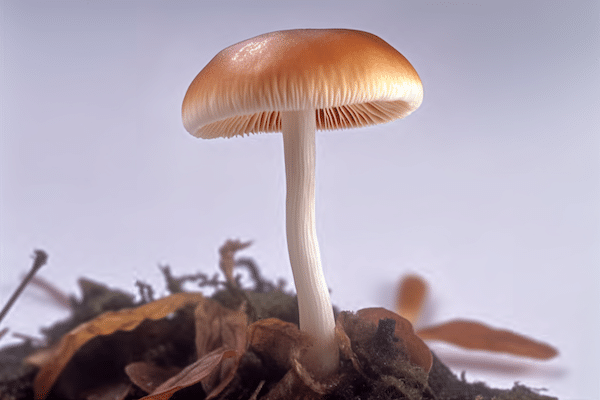
Psilocybin and psilocin are indole alkaloids that have a strong affinity for serotonin receptors, specifically for serotonin 5-HT2A receptors. Psilocin is the main active ingredient that produces the visual and hallucinatory effects of the fungi; when you ingest psilocybin, the body rapidly metabolizes it into the psilocin. Their direct activity on these receptors causes psychoactive effects, including altered perception, visuals, pattern images, euphoria, and mystical experiences.
Read our article to learn what happens to your brain on psilocybin mushrooms.
Many psilocybin species share some common effects, including emotional, cognitive, and physiological changes.
Flying saucer mushrooms produce intense and long-lasting psychedelic experiences accompanied by visual and auditory hallucinations, altered perception of time and space, and profound changes in mood and emotion.
The P. azurescens fungus is high in potency, meaning its psychedelic effects are intense and strong compared to other strains, which makes them appealing to many psychonauts.
One Psilocybe azurescens mushroom user describes his trip:
What I learned on this shroom trip was that I had never had a shroom trip before. I’d had some pretty intense experiences, I’d had some very cool visuals, but never anything like this. The most bizarre part was reliving events and having time lapses. I am a little glad this was confined to my time spent in the field, because it was a little too weird for me. Azures mean business!
Cognitive Effects
Cognitive effects often begin in 30 minutes to an hour, and the overall duration of the trip can be between four and ten hours long.
- Auditory hallucinations
- Sensory synesthesia
- Vivid visual hallucinations
- Altered cognition
Emotional Effects
- Positive mood
- Peace, awe, and joy
- Anxiety, fear, dread
- Gratitude
- Feeling of unity
- Sacredness
- Mystical experiences
- Ego dissolution
Physiological Effects
- Strong body high
- Nausea or vomiting
- Dilated pupils
- Trouble with coordination
- Restlessness
- Dizziness
How Do You Grow Psilocybe Azurescens?
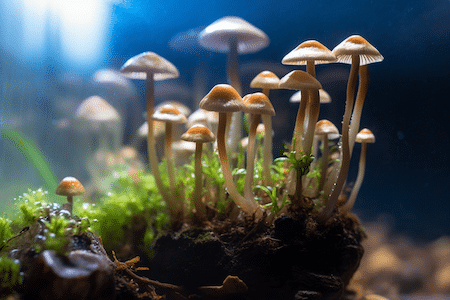
Disclaimer: Growing psilocybin mushrooms for consumption is a potentially illegal activity, and we do not encourage or condone this activity where it is against the law.
Cultivating Psilocybe azurescens indoors can be challenging due to their demanding growing environment and optimal temperature requirements. Many prefer outdoor cultivation of these Azure mushrooms.
The fruiting season of the flying saucer mushrooms typically starts with the first appearance of cold weather around late September. Fruiting continues until December and early January, meaning this Psilocybe species loves the cold. They can bear temperatures as low as -4°C [2].
Cultivating Flying Saucer Mushrooms
Here are some suggestions for cultivating flying saucer mushrooms:
1. Maintain temperatures between 2 to 8° C.
2. Provide long daylight exposure.
3. Use an appropriate substrate, such as wood chips or lignocellulosic material. Alternatively, you could use a “spawn box,” which is a container of wood chips colonized with mycelium [6].
4. Considering outdoor cultivation during the fruiting season, which typically starts in late September and continues until December or early January
If you’re interested in delving into cultivating psilocybin shrooms on your own, check out Third Wave’s Mushroom Grow Kit. Alternatively, you could read our article on how to find psychedelic mushrooms.
Harvesting Tips for Flying Saucer Mushrooms
Psilocybe azurescens can take up to 6 months to fruit, so it’s important to be patient when cultivating them. Many growers also find it challenging to cultivate these mushrooms indoors, as they have specific temperature and environmental requirements.
If you’re interested in learning more about how to grow psychedelic mushrooms, we have a comprehensive article available that covers everything from substrate preparation to harvesting.
However, we must stress that growing psilocybin mushrooms for consumption is illegal in many places, and we do not encourage or condone such activity where it is against the law.
Grow 1 Year's Worth of Microdoses in Just 6 Weeks
Third Wave partnered with top mycologists to create the world’s easiest and best mushroom growing program (kit, course, and expert support).
- Pre-sterilized and sealed
(ready to use out of the box) - Step-by-step video and text course
- Access to growing expert in community
- Make your first harvest in 4-6 weeks
- Average yield is 1 - 4 ounces (28-108g)
- Fits in a drawer or closet
- Enter info for Third Wave discounts:
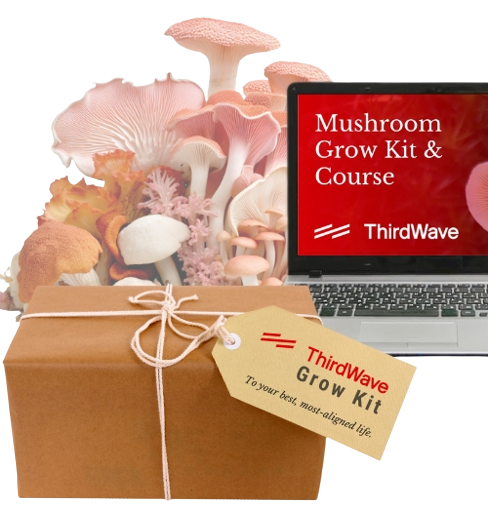
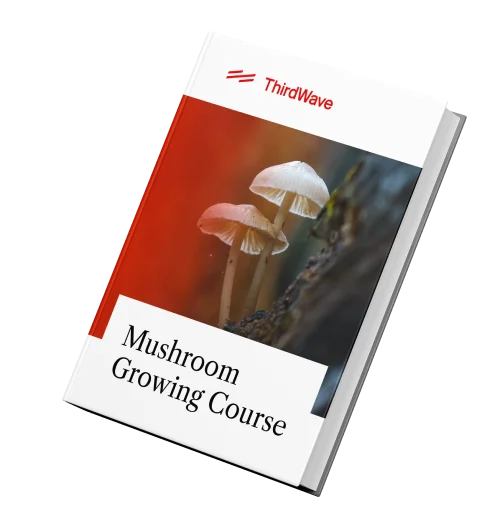
Grow 1 Year's Worth of Microdoses in Just 6 Weeks
Third Wave partnered with top mycologists to create the world’s easiest and best mushroom growing program (kit, course, and expert support).
- Pre-sterilized and sealed
(ready to use out of the box) - Step-by-step video and text course
- Access to experts in community
- Make your first harvest in 4-6 weeks
- Average yield is 1 - 4 ounces (28-108g)
- Fits in a drawer or closet
- Enter info for Third Wave discounts
Psilocybe azurescens Legality
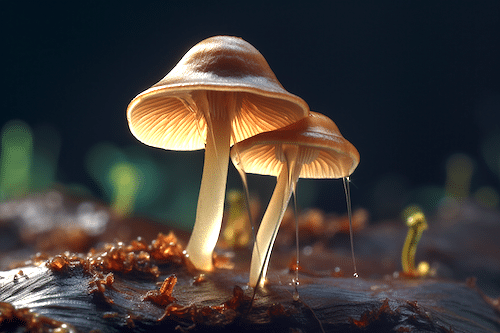
Purchasing mushroom spores is not illegal; growing them is illegal in many places. Psilocybin mushroom spores are often legally sold in the United States, except for California, Georgia, and Idaho.
It’s worth noting that the legality of psilocybin is changing rapidly in many parts of the world. For example, in recent years, several cities in the United States, including Denver and Oakland, have decriminalized the use and possession of psilocybin mushrooms. Additionally, in 2020, Oregon became the first state in the US to legalize the therapeutic use of psilocybin.
However, it’s important to remember that the legality of psilocybin and psilocybin-containing mushrooms varies widely across different jurisdictions, and it is essential to do your research and understand the laws in your area before considering growing or using these substances.
It’s also worth noting that while purchasing mushroom spores may be legal in some areas, there are restrictions on their sale and transportation in other places, so it’s important to understand the relevant laws and regulations.
If you are interested in cultivating psilocybin mushrooms, be aware of the potential risks and legal implications, and take steps to ensure that you are doing so safely and responsibly.
Third Wave’s Magic Mushroom Grow Kit is a helpful resource for those looking to learn more about cultivating psilocybin mushrooms and doing so in a responsible and legal manner.
For more information on the legality of psilocybin mushrooms in your location, check out Third Wave’s Guide on the Legality of Psilocybin Mushrooms.
Microdosing Psilocybe azurescens mushrooms
Microdosing magic mushrooms often means one-tenth of a regular psychedelic dose to benefit from its effects without the visual or hallucinatory features. The effects are often improving mood, creativity, focus, and productivity.
Given the much greater potency of Psilocybe azurescens than other strains, the dose for microdosing is much smaller. However, the experience might be overwhelming since it is difficult to arrange a sub-perceptual dose accurately.
Based on anecdotal reports, users benefit from azurescens affecting their creativity, well-being, depressive thought patterns, and stable mood.
Learn everything about microdosing psilocybin from our ultimate microdosing guide.
Benefits & Risks of Taking Psilocybe azurescens Mushrooms
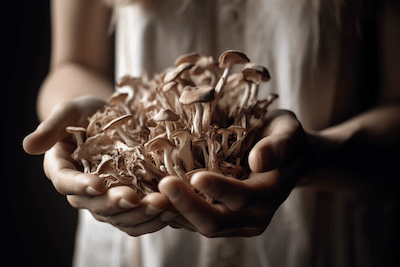
Psilocybe azurescens mushrooms contain high levels of psilocybin and psilocin, which can induce significant shifts in consciousness. As a result, the mushrooms offer potential therapeutic benefits but also carry risks.
Benefits
Some benefits of azure shrooms are the following:
- Transformational and spiritual experiences
- Positive healing/therapeutic effects
- Increased awareness, productivity, and creativity
- Improved mood and energy
- Positive emotional experiences, e.g., feeling oneness, connection, introspection
Risks
There are some risks associated with psilocybin use, both physiological and emotional. A magic mushroom experience can result in “bad trips,” especially if the golden rules of psychedelic trips are not well considered.
Bad trips often include experiences such as:
- Psychosis
- Fear and paranoia
- Anxiety and depression
- Physical changes, e.g., vomiting, nausea, tremors, abnormal heart rate and blood pressure.
The Therapeutic Potential of Psilocybe azurescens
A significant number of studies have proved the potential therapeutic application of psilocybin. Current clinical research continues producing promising results for the future application of this substance in therapy.
So far, psilocybin has been demonstrated to be useful for:
Final Thoughts
Psilocybe azurescens mushrooms have gained popularity due to their high potency and intense psychedelic effects, which can lead to profound and life-changing experiences.
However, their use must be approached with respect and caution, as there are potential risks associated with consuming psilocybin mushrooms. It is important to understand the legal implications of growing and using psilocybin in your area, and to ensure that you are in a safe and supportive environment before consuming them.
For those interested in exploring the cultivation of Psilocybe azurescens for healing and wellness purposes, Third Wave’s Mushroom Grow Kit provides a comprehensive solution. The kit includes high-quality spores, detailed instructions, and ongoing support from experienced cultivators, making it easy for beginners to grow their own mushrooms at home.
Cultivating psilocybin mushrooms can be a rewarding and transformative experience, offering new pathways to healing, growth, and self-discovery. With Third Wave’s guidance and support, you can explore the full potential of these powerful fungi and embark on a journey of personal exploration and transformation.
Grow 1 Year's Worth of Microdoses in Just 6 Weeks
Third Wave partnered with top mycologists to create the world’s easiest and best mushroom growing program (kit, course, and expert support).
- Pre-sterilized and sealed
(ready to use out of the box) - Step-by-step video and text course
- Access to growing expert in community
- Make your first harvest in 4-6 weeks
- Average yield is 1 - 4 ounces (28-108g)
- Fits in a drawer or closet
- Enter info for Third Wave discounts:


Grow 1 Year's Worth of Microdoses in Just 6 Weeks
Third Wave partnered with top mycologists to create the world’s easiest and best mushroom growing program (kit, course, and expert support).
- Pre-sterilized and sealed
(ready to use out of the box) - Step-by-step video and text course
- Access to experts in community
- Make your first harvest in 4-6 weeks
- Average yield is 1 - 4 ounces (28-108g)
- Fits in a drawer or closet
- Enter info for Third Wave discounts
FAQ
Are azurescens mushrooms more potent than cubensis mushrooms?
Yes. Psilocybe azurescens is highly visual and intense in effects compared to Psilocybe cubensis mushrooms. It is said that even one gram can be quite a strong experience.
A psychonaut who has experienced both P. cubensis and P. azurescens shares the following sentiment:
This [P .azurescens trip] was one of the most intense and enjoyable experiences I have ever had. I have experienced cubensis many times before as with entheogens like LSD and salvia, but none of these have been comparable with mushies.
Do Psilocybe azurescens have dangerous look-alikes?
Some wild mushrooms can be potentially mistaken for P. azurescens including the following:
Galerina marginata
Galerina marginata is a fatal poisonous species with similarly structured brown caps that also grows in wood habitats.
The essential aspect to look for is blue bruising – a marker for psilocybin in mushrooms. Galerina does not bruise blue when picked or injured, although Azure’s bruise is quite apparent.
Conocybe filaris
Another potentially fatal species, C.filaris, also shares similar size and color and grows in the same habitat as azurescens; however, they prefer to grow in grassy areas, which is one way to distinguish.
Where can you find P. azurescens mushrooms in the United States?
P. azurescens mushrooms are often found on the west coast of the United States.
The species are often clustered around the Columbia River Delta, Pacific Northwest, Oregon, and Washington, spreading to states such as Idaho and Colorado [1].
Interested in working with psilocybin mushrooms? Take a look at Third Wave’s directory to find legal psilocybin mushroom retreats around the world.
To learn how to grow your mushrooms, Third Wave’s Mushroom Grow Kit provides detailed instructions on the entire cultivation process.
References
[1] Guzman, Gaston; Allen, John W.; Gartz, Jochen (1998). “A Worldwide Geographical Distribution of the Neurotropic Fungi, An Analysis and Discussion.” Annali del Museo Civico di Rovereto. 14: 219, 223. Retrieved 4 September 2017.
[2] Stamets, P. (1996). Psilocybin mushrooms of the world: an identification guide. Ten Speed Press.
[3] Rumack, B. H., & Spoerke, D. G. (1994). Handbook of mushroom poisoning: diagnosis and treatment. CRC press.
[4] Carod-Artal, F. J. (2015). Hallucinogenic drugs in pre-Columbian Mesoamerican cultures. Neurología (English
Edition), 30(1), 42-49. https://doi.org/10.1016/j.nrleng.2011.07.010
[5] Gartz, J. (1996). Magic mushrooms around the world. A scientific journey across cultures and time. LIS publs. Los Angeles.
[6] Nicholas, L. G., & Ogame, K. (2006). Psilocybin mushroom handbook: easy indoor & outdoor cultivation. Ed Rosenthal.

